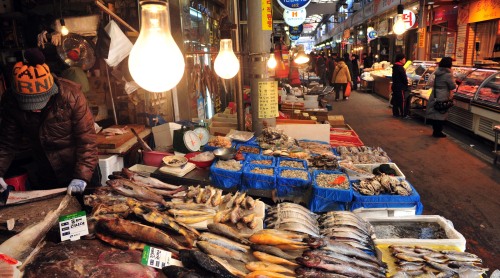Traditional markets losing vitality amid slow sales
By Korea HeraldPublished : Jan. 29, 2012 - 19:40
Customers turn to department stores, supermarket chains
Sai Sachiko, a Tokyo-based school teacher, includes Namdaemun Market in her “must-see routes” whenever she visits Seoul.
“In addition to their quality products, people there, especially middle-aged female merchants, are always energetic and stimulate me in a good way,” she said.
“The atmosphere is totally different from Japanese markets. I can feel warmth and affection unique to Korean traditional markets.”
Many foreign tourists pick the cheap prices and distinctive atmosphere of traditional markets as one of the biggest attractions of Seoul.
In the case of Namdaemun Market, located near the capital’s busiest shopping district of Myeong-dong, about 400,000 people visit the market every day and half of them are foreign nationals.
Despite this increase in tourists, however, traditional markets are rapidly losing their own dynamism in recent years as they are ignored by local customers ― their main source of profits.
There are some 1,500 traditional markets nationwide. Between 2003 and 2010 alone, 178 markets were shut down due to financial struggles.
Their sales also decreased from 36 trillion won ($32 billion) to 24 trillion won during the same period.
They have already been overtaken by department stores and discount chains.
Sales at the nation’s top three department stores, Lotte, Shinsegae and Hyundai, surged from 17.5 trillion won in 2003 to 24.3 trillion in 2010.
Sales at major discount chains E-Mart, Homeplus and Lotte Mart also exceeded traditional markets in 2007, with their combined sales reaching 33.7 trillion won in 2010.
Sai Sachiko, a Tokyo-based school teacher, includes Namdaemun Market in her “must-see routes” whenever she visits Seoul.
“In addition to their quality products, people there, especially middle-aged female merchants, are always energetic and stimulate me in a good way,” she said.
“The atmosphere is totally different from Japanese markets. I can feel warmth and affection unique to Korean traditional markets.”
Many foreign tourists pick the cheap prices and distinctive atmosphere of traditional markets as one of the biggest attractions of Seoul.
In the case of Namdaemun Market, located near the capital’s busiest shopping district of Myeong-dong, about 400,000 people visit the market every day and half of them are foreign nationals.
Despite this increase in tourists, however, traditional markets are rapidly losing their own dynamism in recent years as they are ignored by local customers ― their main source of profits.
There are some 1,500 traditional markets nationwide. Between 2003 and 2010 alone, 178 markets were shut down due to financial struggles.
Their sales also decreased from 36 trillion won ($32 billion) to 24 trillion won during the same period.
They have already been overtaken by department stores and discount chains.
Sales at the nation’s top three department stores, Lotte, Shinsegae and Hyundai, surged from 17.5 trillion won in 2003 to 24.3 trillion in 2010.
Sales at major discount chains E-Mart, Homeplus and Lotte Mart also exceeded traditional markets in 2007, with their combined sales reaching 33.7 trillion won in 2010.

More recently “super-supermarkets,” downsized versions of supermarket chains, have also been mushrooming in every neighborhood amid toughened regulations regarding the business expansion of large retailers.
The number of SSMs has soared from 234 to 928 over the past seven years, with the market growing to reach 6.1 trillion won in sales.
Experts say the sluggish economy is a bigger issue.
“Many customers are low-income earners who are very sensitive to the economic situation,” said Nam Yoon-young, a researcher at Korea Small Business Institute.
“Their spending also recovers more slowly. That’s why traditional markets are hit harder by the economic slowdown than department stores and discount chains.”
It appears unavoidable that customers would favor modern shopping outlets rather than traditional markets that lack convenient facilities.
With the local retail market nearing maturity, the difficulties of traditional markets would continue in the coming years, experts predict.
They say, however, the decline of traditional markets, if not properly handled, could cause more social costs in the longer term.
“Many of the merchants are in their 50s or older. If they lose jobs, their financial struggles are directly led to difficulties of their children,” said Kim Young-ki, a team leader for commercial district development at Agency for Traditional Market Administration.
“Sluggish traditional markets are located in suburban areas where the population is fast aging. Major retailers would not try to enter the area, while many elderly citizens would find nowhere to shop.”
The government should come up with measures to revive traditional markets to reduce welfare expanses following their shutdown, Kim said.
Japan also experienced a similar problem in the late 1990s when its traditional shopping arcades were closed amid an aging population and a low birth rate.
The Japanese government, under the leadership of prime minister, launched a revival project that aimed at rebuilding not just a business district but also the whole community.
“Public facilities like libraries and government offices were moved to the market areas to attract more customers. Merchants also organized a management group to improve overall services,” Kim said.
Similar programs were also conducted in European countries.
The Korean government also adopted a special law that supports the modernization of traditional markets in 2005, along with toughening regulations to ban excessive expansion of major retailers.
According to a study by the Agency for Traditional Market Administration, traditional markets, after undergoing facility renovation, showed a 7 percent increase in sales on average, while those making less efforts saw a 20 percent decrease.
Kim said tougher regulations, like the recent limitations on business hours of major retailers, cannot be the fundamental solution.
“The government is trying to find ways for cooperation between large retailers and small vendors. Individual merchants also need to have better service mentality to adapt to the changing consumer trend,” he said.
By Lee Ji-yoon (jylee@heraldcorp.com)
-
Articles by Korea Herald







![[New faces of Assembly] Architect behind ‘audacious initiative’ believes in denuclearized North Korea](http://res.heraldm.com/phpwas/restmb_idxmake.php?idx=644&simg=/content/image/2024/05/01/20240501050627_0.jpg&u=20240502093000)











![[Today’s K-pop] Sunmi to drop single next month](http://res.heraldm.com/phpwas/restmb_idxmake.php?idx=642&simg=/content/image/2024/05/03/20240503050545_0.jpg&u=)